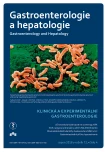Hyponatremia in the context of gastrointestinal diseases
Authors:
L. Vítová
Authors‘ workplace:
Interní klinika LF UK a FN Motol, Praha
Published in:
Gastroent Hepatol 2018; 72(4): 345-350
Category:
doi:
https://doi.org/10.14735/amgh2018345
Overview
Diseases of the gastrointestinal tract (GIT) often lead to changes in the homeostasis of serum electrolyte concentrations and of acid-base and water balance. There is a large turn in water and electrolytes throughout the digestive tract. GIT is involved in electrolyte balance, water absorption, and excretion. GIT mucosa secretes a large amount of juices. Pathological conditions (increased secretion or decreased reabsorption) contribute to the deregulation of homeostasis of the internal environment. These disorders can vary in intensity from accidentally detected laboratory abnormalities to life-threatening conditions. The following review article addresses hyponatremia – the most common disorder of the internal environment – in the context of GIT diseases. The various clinical situations that may be associated with hyponatremia are discussed. In addition, hyponatremia is often accompanied by a number of other abnormalities of the internal environment, these must be respected during the treatment. It is necessary to obtain a range of data – both anamnestic and laboratory data – including changes in these data during the course of treatment. Equally important is the careful execution of a basic physical examination focusing on hydration. Understanding the pathophysiological mechanisms that lead to hyponatremia, along with detailed clinical-laboratory image analysis, is the only way to obtain an accurate differential diagnosis of hyponatremia. For physicians across all areas of expertise, it is important to perform recommended laboratory tests prior to therapy initiation, afterwards these data enable us the correct interpretation of the abnormalities.
Key words:
gastrointestinal diseases – disorders of homeostasis – hyponatremia
The author declares he has no potential conflicts of interest concerning drugs, products, or services used in the study.
The Editorial Board declares that the manuscript met the ICMJE „uniform requirements“ for biomedical papers.
Submitted: 28. 6. 2018
Accepted: 3. 8. 2018
Sources
1. Abola MV, Tanenbaum JE, Bomberger TT et al. Preoperative hyponatremia is associated with reoperation and prolonged length of hospital stay following total knee arthroplasty. J Knee Surg 2018. In press. doi: 10.1055/ s-0038-1641156.
2. Vieira J, Nunes G, Santos CA et al. Serum electrolytes and outcome in patients undergoing endoscopic gastrostomy. Arq Gastroenterol 2018; 55 (1): 41–45. doi: 10.1590/S0004-2803. 201800000-05.
3. Holland-Bill L, Christiansen CF, Farkas DK et al. Diagnosis of hyponatremia and increased risk of a subsequent cancer diagnosis: results from a nationwide population-based cohort study. Acta Oncol 2018; 57 (4): 522–527. doi: 10.1080/0284186X.2017.1378430.
4. Chung MC, Yu TM, Shu KH et al. Hyponatremia and increased risk of dementia: A population-based retrospective cohort study. PLoS One 2017; 12 (6): e0178977. doi: 10.1371/journal.pone.0178977.
5. Choi JS, Kim CS, Bae EH et al. Prognostic impact of hyponatremia occurring at various time points during hospitalization on mortality in patients with acute myocardial infarction. Medicine (Baltimore) 2017; 96 (23): e7023. doi: 10.1097/MD.0000000000007023.
6. Al Mawed S, Pankratz VS, Chong K et al. Low serum sodium levels at hospital admission: Outcomes among 2.3 million hospitalized patients. PLoS One 2018; 13 (3): e0194379. doi: 10.1371/journal.pone.0194379.
7. Čertíková-Chábová V. Exkrece sodíku, chloridů a vody, regulace objemu extracelulární tekutiny. In: Tesař V, Viklický O (eds). Klinická nefrologie. 2. vyd. Praha: Grada Publishing 2015 : 16–21.
8. Spasovski G, Vanholder R, Allolio B et al. Clin-ical practice guideline on diagnosis and treatment of hyponatraemia. Nephrol Dial Transplant 2014; 29 (Suppl 2): i1-i39. doi: 10.1093/ndt/gfu040.
9. Schück O. Poruchy metabolismu vody a elektrolytů s klinickými případy. Hyponatremie. 1. vyd. Praha: Grada Publishing 2013: 64–65.
10. Ehrmann J. Diferenciální diagnostika průjmu a možnosti léčby. Interní Med 2011; 13 (4): 167–170.
11. Gottfriedová H, Horáčková M, Čáslavská M et al. Poruchy vodního a elektrolytového metabolismu a změny acidobazické rovnováhy u pacientů s ascitickou cirhózou jater. Čas Lék čes 2017; 156 : 150–152.
12. Liamis G, Milionis H, Elisaf M. A review of drug-induced hyponatremia. Am J Kidney Dis 2008; 52 (1): 144–153. doi: 10.1053/j.ajkd.2008.03.004.
13. Costa JM, Soares JB. Symptomatic hyponatremie after bowel preparation: report of two cases and literature review. Acta Med Port 2017; 30 (11): 824–826. doi: 10.20344/amp.8794.
14. Adrogué HJ, Madias NE. Hyponatremia. N Engl J Med 2000; 342 (21): 1581–1589
Labels
Paediatric gastroenterology Gastroenterology and hepatology SurgeryArticle was published in
Gastroenterology and Hepatology

2018 Issue 4
- Metamizole vs. Tramadol in Postoperative Analgesia
- Metamizole at a Glance and in Practice – Effective Non-Opioid Analgesic for All Ages
- The Importance of Limosilactobacillus reuteri in Administration to Diabetics with Gingivitis
- Safety and Tolerance of Metamizole in Postoperative Analgesia in Children
Most read in this issue
- Hyponatremia in the context of gastrointestinal diseases
- Mastocytic enterocolitis as a possible cause of chronic diarrhea
- EUS guided drainages with novel electrocautery-enhanced apposing metal stents (stent Hot AXIOS) in a cohort of 20 patients
- Methotrexate – rediscovered drug for Crohn’s disease
